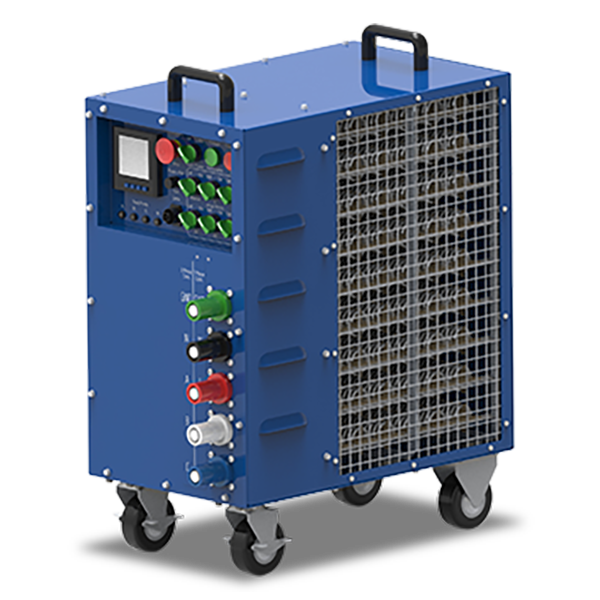Load Bank
At VP Tech Control, we offer high-quality Load Banks designed for testing, commissioning, and maintaining the performance of electrical power systems, including generators, UPS (Uninterruptible Power Supplies), transformers, and other electrical equipment. Our Load Banks are engineered to provide a controlled load, enabling you to perform accurate, safe, and efficient testing to ensure that your electrical systems can handle operational demands without failure. Whether you’re preparing for a system upgrade, conducting routine maintenance, or performing load testing, our load banks provide the reliability and precision you need.
What is a Load Bank?
A Load Bank is a device used to simulate an electrical load for testing and verifying the performance of power sources like generators, UPS systems, and transformers. By applying a specific, controllable electrical load to the system, a load bank ensures that the equipment functions properly under operational conditions. Load banks are commonly used in both preventative and corrective maintenance programs to validate system performance, improve reliability, and ensure the system can handle its rated capacity without issues.
Key Features of Our Load Banks:
1. Accurate and Adjustable Load Simulation
Our load banks provide a precise and adjustable electrical load that can simulate real-world conditions for testing purposes. The user can adjust the load based on the equipment’s specifications and requirements, ensuring accurate testing for a wide range of systems.
2. Safe and Reliable Testing
Load Banks offer safe operation by providing controlled conditions for electrical testing. Whether you are testing a generator’s load capacity, performing routine maintenance, or checking the response of backup systems, our load banks ensure that the equipment being tested operates within safe parameters, preventing damage from underloading or overload conditions.
3. Versatile Application
Our Load Banks are designed for use in a variety of applications, including:
- Generator Load Testing: Testing the full capacity of backup generators to ensure they are prepared for emergency situations.
- UPS (Uninterruptible Power Supply) Testing: Verifying that UPS systems are able to handle power loads and provide uninterrupted power during outages.
- Transformer Load Testing: Ensuring transformers can handle and distribute the required load without overheating or malfunctioning.
- Battery and DC Systems Testing: For evaluating battery performance and testing DC systems in both industrial and commercial settings.
- Routine Maintenance and System Diagnostics: Verifying the reliability of power systems during maintenance and repairs.
4. Various Load Types and Sizes
We provide load banks in a variety of load types—resistive, reactive, or a combination of both—depending on the specific testing requirements. Additionally, our load banks come in different sizes and configurations to suit both small-scale and large-scale operations, ensuring flexibility for diverse needs.
5. User-Friendly Interface
Our Load Banks come with easy-to-use interfaces, providing operators with clear digital or analog readings on parameters such as voltage, current, frequency, and power. This ensures that users can easily monitor and control the testing process.
6. Portability and Compact Design
Our Load Banks are designed for easy mobility and deployment, whether in a stationary location or for on-site use. They are compact and lightweight without compromising on performance, making them ideal for both temporary and long-term testing solutions.
7. Robust Construction for Harsh Environments
Built with durability in mind, our Load Banks are designed to withstand harsh industrial environments, including extreme temperatures, high humidity, and dust. The robust design ensures that the units remain reliable and efficient in challenging operational conditions.
8. Compliance with International Standards
Our Load Banks are manufactured in compliance with international standards such as IEC, UL, and CE, ensuring that they meet high safety, quality, and performance benchmarks. They are thoroughly tested to meet industry regulations and are safe to use in a wide range of electrical applications.
Applications of Load Banks:
- Generator Testing and Commissioning: Load banks are used extensively to test backup generators during commissioning, maintenance, and load testing procedures. By applying a full load to the generator, users can verify that the generator is operating correctly and that its capacity meets the required specifications.
- Uninterruptible Power Supply (UPS) Systems: Load banks allow for comprehensive testing of UPS systems to ensure that they can handle the load during power outages. UPS systems can be verified for their ability to provide seamless power transfer during load conditions, ensuring they meet backup power requirements.
- Transformer Load Testing: Load banks can be used to simulate electrical loads on transformers, helping to verify their efficiency, capacity, and performance under operational conditions. This testing ensures that transformers do not experience overheating or failure during normal operation.
- Data Centers: In data centers, where continuous power is critical, load banks are used for testing generators, UPS systems, and other electrical systems to ensure that they meet power demands and can provide reliable backup when required.
- Manufacturing Facilities: In manufacturing settings, where equipment uptime is essential, load banks are used to ensure that backup power sources and electrical systems can handle peak loads without failure. This testing helps prevent operational disruptions in case of power interruptions.
- Marine and Offshore: Load banks are frequently used in the marine and offshore industries for generator load testing to ensure that power systems on vessels, rigs, and platforms can handle the electrical demands of critical equipment and systems.
- Renewable Energy Systems: Load banks are used to test the performance and capacity of renewable energy systems, such as solar or wind power plants, ensuring that power generated can be properly distributed to the grid or used for onsite needs.
